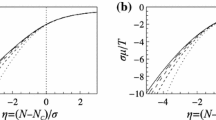Abstract
The zero temperature limit of statistical mechanical systems in the grand canonical ensemble is calculated using the methods of tropical algebraic geometry. Particularly, the grand potentials are interpreted as tropical Laurent polynomials in two variables which parametrises the energy and chemical potential of the system. Plotting the roots of these tropical polynomials gives a visual representation of the states of systems at zero temperature. These curves satisfies the balancing condition obeyed by all tropical polynomials. Furthermore, it is proven that the balancing condition continues to hold for tropical ‘polynomials’ with rational exponents. These methods are then applied to various simple physical systems and toy models.










Similar content being viewed by others
Change history
04 June 2021
The original online version of this article was revised to update reference 20.
Notes
We shall denote vectors in \(\mathbb {R}^2\) by the notation \(\mathbf {u}=\langle x,y \rangle =x\,\hat{\imath }+y\,\hat{\jmath }\).
A more precise mathematical definition for \(\hat{u}\) is a vector such that there exists a positive real number k with \(\mathbf {u}=k\hat{u}\), where the integer length of \(\hat{u}\) is equal to one (i.e., the cardinality of \([Oz_{\tilde{u}}]\cap \mathbb {Z}^2\)).
Note that \(\varPsi _{\mathrm {trop}}=-\mathcal {N}\psi \) has an overall prefactor \(\mathcal {N}\). Then one has to multiply \(\epsilon _ix\) and \(N_j\) by \(\mathcal {N}\) to obtain the correct total energy and number of particles.
References
Itenberg, I., Mikhalkin, G.: Geometry in the tropical limit. Math. Semesterber 59, 57–73 (2012)
Viro, O.: On basic concepts of tropical geometry. Proceedings of the Steklov Institute of Mathematics 273, (07) 252 (2011)
Maclagan, D.: Introduction to tropical algebraic geometry. arXiv:1207.1925
Mikhalkin, M., Rau, J.: Tropical geometry. 2018 (accessed July 13, 2019). https://www.math.uni-tuebingen.de/user/jora/downloads/main.pdf
Rau, J.: A first expedition totropical geometry. 2017 (accessed July 13, 2019). https://www.math.uni-tuebingen.de/user/jora/downloads/FirstExpedition.pdf
Itenberg, I., Mikhalkin, G., Shustin, E.: Tropical algebraic geometry. Birkhauser Basel, (2009)
Chan, M.: Lectures on tropical curves and their moduli spaces. arXiv:1606.02778
Feng, B., He, Y.-H., Kennaway, K.D., Vafa, C.: Dimer models from mirror symmetry and quivering amoebae. Adv. Theor. Math. Phys. 12, 489–545 (2008)
Litvinov, G.L., Maslov, V.P.: Idempotent mathematics: correspondence principle and applications. Russ. Math. Surv. 51, 1210–12221 (1996)
Litvinov, G. L.: Tropical mathematics, idempotent analysis, classical mechanics and geometry. arXiv:1005.1247
Kolokoltsov, V., Maslov, V.P.: Idempotent Analysis and its Applications. Springer, Berlin (1997)
Pachter, L., Sturmfels, B.: Tropical geometry of statistical models. PNAS 101, 16132–16137 (2004)
Kapranov, M.: Thermodynamics and the moment map. arXiv:1108.3472
Kenyon, R., Okounkov, A., Sheffield, S.: Dimers and amoebae. Ann. Math. 163, 1019–1036 (2006)
Passare, M., Pochekutov, D., Tsikh, A.: Amoebas of complex hypersurfaces in statistical thermodynamics. Math. Phys. Anal. Geom. 16, 89–108 (2013)
Angelelli, M., Konopelchenko, B.: Zeros and amoebas of partition functions. Rev. Math. Phys. 30, 1850015 (2018)
Marcolli M., Thorngren, R.: Thermodynamic semirings. arXiv:1108.2874
Marcolli, M., Tedeschi, N.: Entropy algebras and Birkhoff factorization. J. Geom. Phys. 97, 243–265 (2015)
Angelelli, M., Konopelchenko, B.: Tropical limit in statistical physics. Phys. Lett. A 379, 1497–1502 (2015)
Angelelli, M.: Tropical limit and a micro-macro correspondence in statistical physics. J. Phys. A: Math. Theor. 50(41), 415202 (2017). https://doi.org/10.1088/1751-8121/aa863b
Callen, H.B.: Thermodynamics and an Introduction to Thermostatistics. Wiley, Hoboken (1985)
Balescu, R.C.: Equilibrium and Non-Equilibrium Statistical Mechanics. Wiley, Hoboken (1975)
Huang, K.: Statistical Mechanics. Wiley, Hoboken (1987)
Gelfand, I.M., Kapranov, M.M., Zelevinsky, A.V.: Discriminants, Resultants, and Multidimensional Determinants. Birkhäuser Boston Inc, Boston (1994)
Nisse, M., Sottile, F.: The phase limit set of a variety. Algebra Number Theory 7, 339–352 (2011)
Nisse, M., Sottile, F.: Non-Archimedean coamoebae. Contemp. Math. Am. Math. Soc 605, 73–91 (2013)
Mikhalkin, G.: tropical geometry and its applications. Int. Cong. Math. I I, 827–852 (2006)
Author information
Authors and Affiliations
Corresponding author
Ethics declarations
Conflict of interest
The authors declare that they have no conflict of interest.
Additional information
Publisher's Note
Springer Nature remains neutral with regard to jurisdictional claims in published maps and institutional affiliations.
MN is supported by Xiamen University Malaysia Research Fund (Grant No. XMUMRF/ 2020-C5/IMAT/0013). Y-KL is supported by Xiamen University Malaysia Research Fund (Grant No. XMUMRF/ 2019-C3/IMAT/0007)
Rights and permissions
About this article
Cite this article
Nisse, M., Lim, YK. The zero-temperature limit of grand canonical ensembles via tropical geometry. Anal.Math.Phys. 11, 113 (2021). https://doi.org/10.1007/s13324-021-00555-8
Received:
Revised:
Accepted:
Published:
DOI: https://doi.org/10.1007/s13324-021-00555-8



